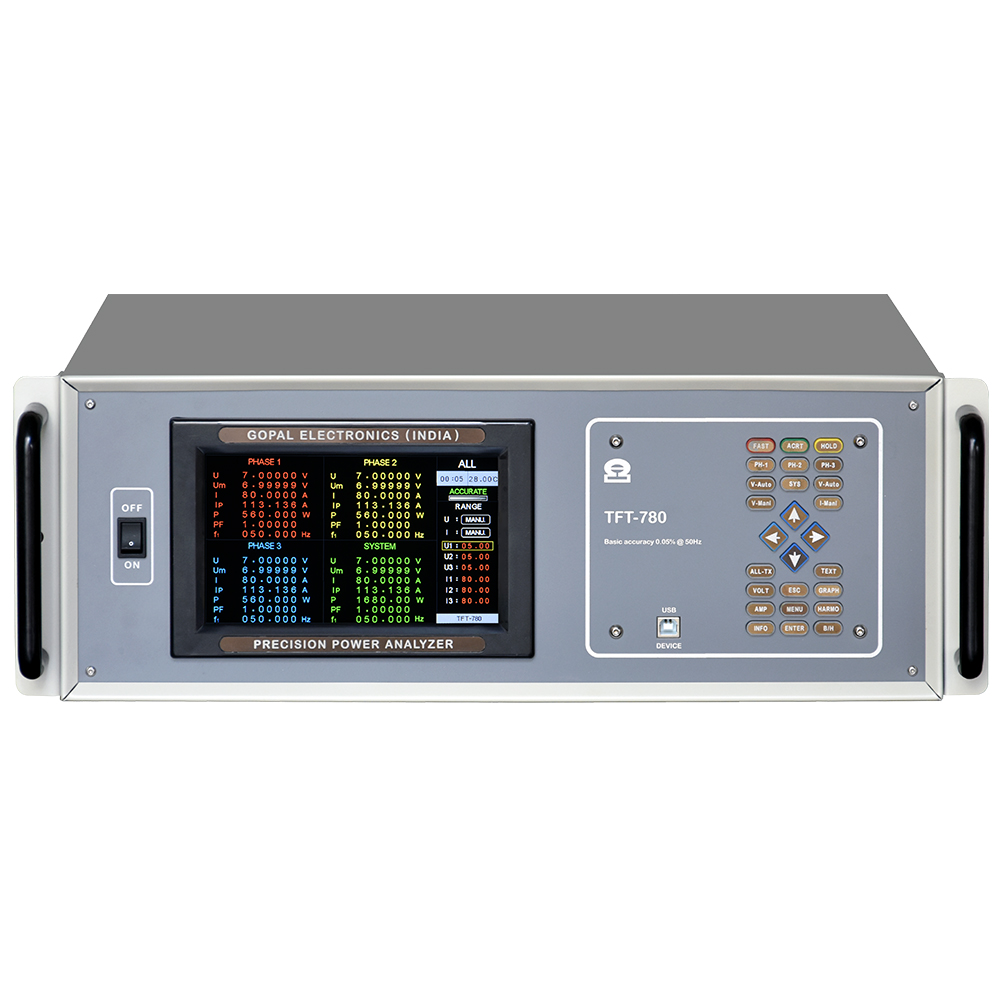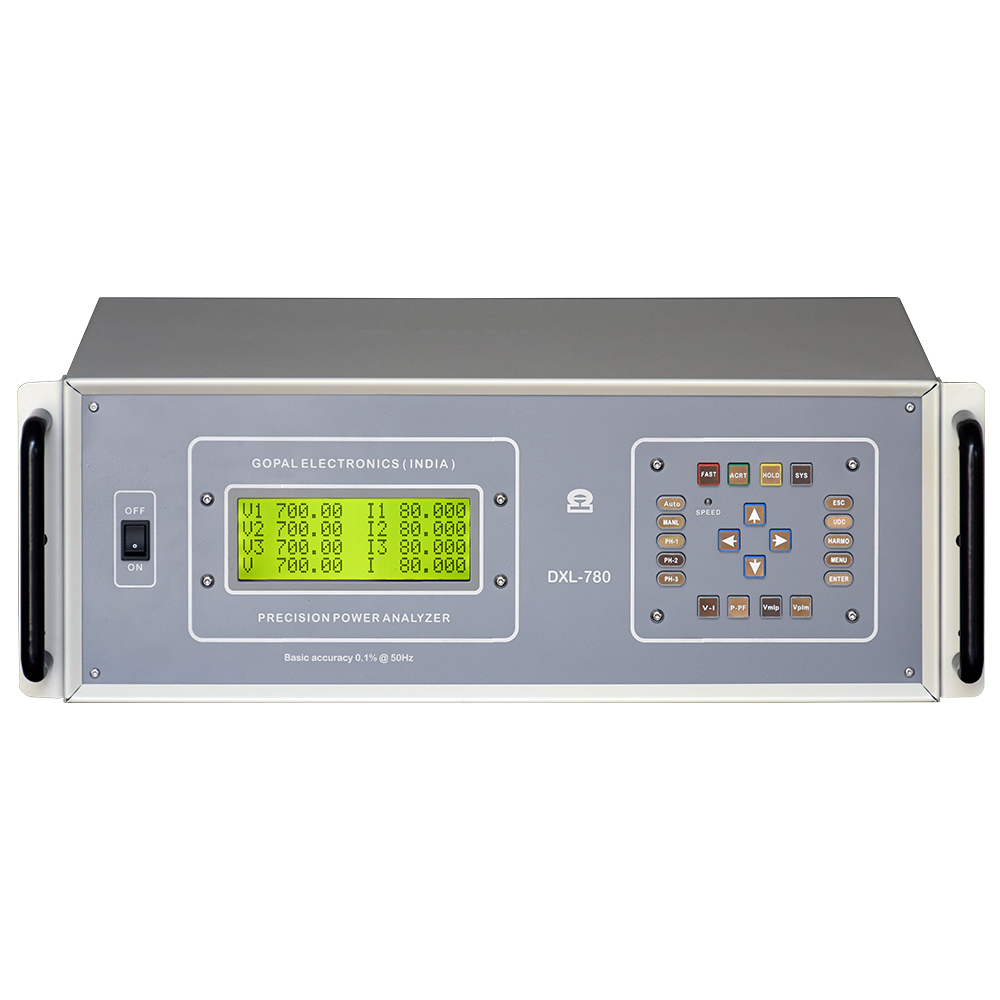Description
Introducing the three Phase Power Analyzer TFT780 :
Three Phase Power Analyzer PA700TFT is multi-range power Analyzer with basic 0.05% R+R accuracy. 8 range of voltage, 8 range of current and total 64 range of power and power factor gives more accurate result at low power factor. It has waveform mode to check the waveform of voltage and current. As well it has B/H curve mode where user can check live b/h curve of the transformer under test. The gap less four-quadrant power measurement technique gives better accuracy at distorted waveforms or AC drive (VFD) operated power supply.
Features of three Phase Power Analyzer TFT780 :
Three Phase Power Analyzer PA700TFT series Power Analyzer has given revolution in testing of distribution and power transformer with the advanced feature of hysteresis (B/H) analysis. Core loss & winding loss measurement is important in transformer testing. In conventional method, three phase power Analyzer used with digital oscilloscope and phase converter to calculate knee value and saturation point of core. PA700TFT eliminate the requirement of multiple equipment and made the testing more easy by inbuilt hysteresis measurement mode. Which plot live hysteresis curve, so derivation of knee and saturation value is easy.
Advantages of three Phase Power Analyzer TFT780 :
Any distortion in line power directly reflect on the measurement, Three Phase Power Analyzer PA700TFT has waveform display mode which gives d(y) / d(t) of line voltage and current. In addition, there is facility of zoom in and zoom out to get precise analysis.
Three Phase Power Analyzer PA700TFT provides facility to selection speed of measurement by keypad. It play big role during setting test voltage and current in transformer testing. User can set fast speed mode during setting of test voltage and current and then accurate mode during fine measurement. It saves time in make testing easy.
check product Demo on : Our Youtube Channel
-
7" Graphics Display
Big Display is very useful to check all parameter in single display without scrolling any page
-
Multi Range
Multi range offers linear accuracy while testing small to big size transformer. Specially beneficial when using external CT/PT
-
Harmonics
Harmonics measurement up to 64th element can be measure
Application Note
Any testing equipment defines it’s accuracy at full scale value. for example a volt meter of 1000V range with 0.1% accuracy can achieve 0.1% accuracy at 1000V not at 1V. If you measure 1V in that volt meter it can give tremendous error. 0.1% error of 1000v is 1V. It means when you are measuring 1v in such volt meter can show you reading 0V or 2V means it has 100% error.
Multi range equipment is more beneficial and highly accurate for their entire measuring range. So user can achieve linear accuracy from milli volt to 1000V. So in multi range equipment user will be able to test small transformer like 100VA to big transformer like 10MVA
Harmonics measurement in transformer testing is important for several reasons:
Quality of Power Supply: Transformers are vital components in power distribution systems. Harmonics in the power supply can be generated by non-linear loads such as computers, variable speed drives, and other electronic equipment. These harmonics can affect the quality of the power supply and, in turn, impact the performance and efficiency of transformers.
Overheating and Losses: Harmonics can cause additional losses in transformers, leading to overheating. Transformers are designed to operate efficiently with sinusoidal voltages and currents. When non-sinusoidal waveforms with harmonics are present, they can cause increased eddy current and hysteresis losses in the transformer’s core, leading to higher temperatures.
Transformer Design and Sizing: Harmonics can affect the design and sizing of transformers. Excessive harmonics may require transformers to be oversized to handle the additional losses and heating caused by non-sinusoidal waveforms. Properly understanding the harmonic content helps in designing transformers that can operate effectively under real-world conditions.
Compliance with Standards: Various international standards, such as IEEE standards, set limits on the acceptable levels of harmonics in power systems. Harmonics measurement in transformer testing ensures that the transformers comply with these standards and operate within acceptable limits.
Diagnostic Tool: Harmonic analysis can serve as a diagnostic tool to identify problems in the power system. Unusual harmonic patterns can indicate issues with connected loads or other components in the system. By monitoring harmonics, maintenance and troubleshooting efforts can be more targeted and efficient.
Power Quality Analysis:Power analyzers can assess the quality of the electrical power supplied to a transformer. They monitor parameters such as voltage, current, power factor, and harmonics to identify any deviations from the ideal sinusoidal waveform.
Power quality analysis helps in ensuring that the transformer operates under optimal conditions and is not subjected to abnormal voltage or current fluctuations.
Efficiency Testing:Power analyzers are used to measure the input and output power of transformers. By comparing these values, the efficiency of the transformer can be calculated. This is essential for evaluating the performance and energy efficiency of the transformer under various load conditions.
Load Profiling:Power analyzers help in creating load profiles by monitoring the transformer’s electrical parameters over time. This information is valuable for understanding the transformer’s behavior under different load conditions, which aids in optimizing its operation and preventing overloading.
Harmonic Analysis:Power analyzers can measure harmonics in the electrical system. Transformers are sensitive to harmonics, and excessive harmonic content can lead to increased losses and reduced efficiency.
Harmonic analysis using power analyzers helps in identifying and mitigating harmonic issues to prevent transformer overheating and other related problems.
Transformer Losses Measurement:Power analyzers quantify losses in transformers by measuring the input and output power. This includes both copper losses (I²R losses) and core losses.
Accurate measurement of losses is essential for assessing the overall efficiency and performance of the transformer.
Voltage and Current
Monitoring:Power analyzers continuously monitor the voltage and current levels in the transformer. Any deviations from the specified values can be quickly identified, allowing for prompt corrective actions to be taken.
Checking the voltage and current waveforms during transformer testing is essential for several reasons:
Quality of Power Supply:
Transformers are designed to operate with sinusoidal voltage and current waveforms. Deviations from the ideal sinusoidal waveforms can indicate issues with the quality of the power supply. Monitoring the voltage and current waveforms helps ensure that the transformer receives a stable and well-conditioned power supply, which is crucial for its proper operation.
Identification of Voltage Sag or Swell: Voltage waveforms are checked to identify any sags (temporary decreases) or swells (temporary increases) in voltage. These variations can affect the performance and lifespan of the transformer. Detecting and analyzing voltage anomalies helps in implementing corrective measures and protecting the transformer from potential damage.
Evaluation of Power Factor: Power factor is a measure of how effectively electrical power is being converted into useful work output. Power factor is influenced by the phase relationship between voltage and current waveforms.
Checking the voltage and current waveforms is crucial for accurately determining and optimizing the power factor, ensuring efficient power usage.
Harmonic Analysis: Harmonics are non-sinusoidal components superimposed on the fundamental sinusoidal waveforms. Excessive harmonics in voltage and current can lead to increased losses, overheating, and reduced efficiency in transformers.
Monitoring the waveforms allows for harmonic analysis, helping to identify and mitigate harmonic issues that may impact the transformer’s performance.
Detection of Transients: Transients, such as voltage spikes or surges, can occur in the power supply. Monitoring voltage waveforms helps identify these transient events, which can potentially damage the transformer insulation and affect its reliability.
Taking corrective actions based on transient analysis can prevent transformer damage and ensure its long-term functionality.
understanding how the transformer responds to varying loads and identifying any irregularities in its performance under different operating conditions.
Some of reputed customers
- Gujarat Plug in Device (Baroda) = 3Nos
- Digvijay Industries (Aurangabad)
- Elmas Magnetics
- Ujjain Engineering college (Ujjain)
- Vishwakarma Government Engineering College (Ahmedabad)
- ATLAS TRANSFORMERS INDIA LIMITED (Ahmedabad)
- Ferromag Technologies (Ahmedabad)
- COMPANIA ELECTRO ANDINA S A C (PERU)
- Wilson Power (Chennai)
- Delta Rototech (Salem)





Reviews
There are no reviews yet.